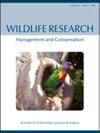Genetic analysis reveals spatial structure in an expanding introduced rusa deer population
IF 1.6
3区 生物学
Q3 ECOLOGY
引用次数: 2
Abstract
ABSTRACT Context Rusa deer (Cervus timorensis), originally introduced in the 1860s, are still spreading in eastern Australia. The expanding peri-urban rusa deer population in the Illawarra region of New South Wales, Australia is having undesirable impacts on human and ecological communities, but the spatial structure of this population has not been investigated. Genetic information on invasive species is potentially useful in identifying management units to mitigate undesirable impacts. Aim The aim of this study was to investigate population structure, characterise dispersal, and determine if natural and human-made landscape features affected gene flow in rusa deer invading the Illawarra region of New South Wales. Methods We used reduced representation sequencing (DArT-Seq) to analyse single nucleotide polymorphisms distributed throughout the genomic DNA of rusa deer culled during a management program. We used admixture and Principal Component Analyses to investigate population structure with respect to natural and human-made landscape features, and we investigated whether our genetic data supported the presence of sex-biased dispersal. Key results Genetic diversity was highest in the north, near the original introduction site. A railway line demarcated restricted gene flow. Surprisingly, the Illawarra escarpment, a prominent landscape feature, did not restrict gene flow. There was no evidence of sex-biased dispersal and seven individuals were identified as genetic outliers. Conclusions The genetic structure of the Illawarra rusa deer population is consistent with individuals spreading south from their introduction site in Royal National Park. The population is not panmictic, and a landscape feature associated with urbanisation was associated with increased spatial genetic structure. Outliers could indicate hybridisation or secondary incursion events. Implications Rusa deer can be expected to continue invading southwards in the Illawarra region, but landscape features associated with urbanisation might reduce dispersal across the landscape. The genetic structuring of the population identified three potential management units on which to prioritise ground shooting operations.遗传分析揭示了扩大引进鹿种群的空间结构
摘要背景鹿鹿(Cervus timorensis)最初于19世纪60年代引进,目前仍在澳大利亚东部传播。澳大利亚新南威尔士州伊拉瓦拉地区城市周边鹿群的不断扩大对人类和生态群落产生了不良影响,但鹿群的空间结构尚未得到调查。入侵物种的遗传信息在确定管理单位以减轻不良影响方面可能有用。本研究的目的是调查种群结构、分布特征,并确定自然和人为景观特征是否影响入侵新南威尔士州伊拉瓦拉地区的鲁沙鹿的基因流动。方法采用减少代表性测序(DArT-Seq)方法分析在管理程序中被扑杀的鹿群基因组DNA中分布的单核苷酸多态性。我们利用混合分析和主成分分析来研究自然和人为景观特征的种群结构,并研究我们的遗传数据是否支持性别偏倚分散的存在。主要结果遗传多样性在靠近原引种地的北部地区最高。一条铁路线划定了有限制的基因流动。令人惊讶的是,伊拉瓦拉悬崖,一个突出的景观特征,并没有限制基因流动。没有证据表明有性别偏见的分散,有7个人被确定为遗传异常值。结论伊拉瓦拉鹿种群的遗传结构与从皇家国家公园引进地向南扩散的个体一致。人口不是泛型的,与城市化相关的景观特征与空间遗传结构的增加有关。异常值可能表明杂交或继发性入侵事件。在伊拉瓦拉地区,鹿群可能会继续向南入侵,但与城市化相关的景观特征可能会减少鹿群在整个景观中的分布。种群的遗传结构确定了三个潜在的管理单位,以确定地面射击行动的优先次序。
本文章由计算机程序翻译,如有差异,请以英文原文为准。
求助全文
约1分钟内获得全文
求助全文
来源期刊

Wildlife Research
生物-动物学
CiteScore
4.30
自引率
15.80%
发文量
56
审稿时长
3 months
期刊介绍:
Wildlife Research represents an international forum for the publication of research and debate on the ecology, management and conservation of wild animals in natural and modified habitats. The journal combines basic research in wildlife ecology with advances in science-based management practice. Subject areas include: applied ecology; conservation biology; ecosystem management; management of over-abundant, pest and invasive species; global change and wildlife management; diseases and their impacts on wildlife populations; human dimensions of management and conservation; assessing management outcomes; and the implications of wildlife research for policy development. Readers can expect a range of papers covering well-structured field studies, manipulative experiments, and analytical and modelling studies. All articles aim to improve the practice of wildlife management and contribute conceptual advances to our knowledge and understanding of wildlife ecology.
Wildlife Research is a vital resource for wildlife scientists, students and managers, applied ecologists, conservation biologists, environmental consultants and NGOs and government policy advisors.
Wildlife Research is published with the endorsement of the Commonwealth Scientific and Industrial Research Organisation (CSIRO) and the Australian Academy of Science.
 求助内容:
求助内容: 应助结果提醒方式:
应助结果提醒方式:


